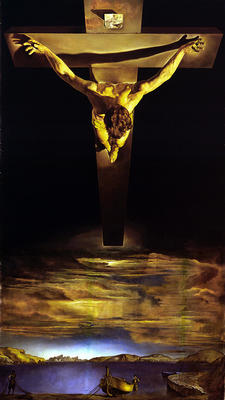
Fifth Sorrowful Mystery: The Crucifixion of Our Lord
1.36k
 That we Catholics so frequently see crucifixes in our homes and churches might, in a certain way, desensitize us to the horrors that it represents in a relatively sanitised form. The crucifix—which we proudly wear as a symbol of our faith and a sign of hope—is a remembrance of a gruesome and barbaric act of inhumanity, a depiction of the gravest historical injustice imaginable (simultaneously the cruel murder of a totally innocent man, perpetrated for personal expedience but enacted in the name of a fake justice, and the desecration of God’s only begotten).
That we Catholics so frequently see crucifixes in our homes and churches might, in a certain way, desensitize us to the horrors that it represents in a relatively sanitised form. The crucifix—which we proudly wear as a symbol of our faith and a sign of hope—is a remembrance of a gruesome and barbaric act of inhumanity, a depiction of the gravest historical injustice imaginable (simultaneously the cruel murder of a totally innocent man, perpetrated for personal expedience but enacted in the name of a fake justice, and the desecration of God’s only begotten).
Yet it is in this moment—the moment when Jesus looks most unlike God, most reducible to that which is rejected by humans—that the depths of divine love are revealed: in the veiling of his death, Christ’s true identity as God’s own way of reaching out and loving humanity is revealed. God wills, in the mystery of Christ’s suffering, death and resurrection, to love us into new communion with Himself, thereby bestowing new meaning on human suffering itself. This man of sorrows was never without the joy of the beatific vision.
Through the eyes of faith, then, we see Christ’s own perfect self-offering as priest and victim, a true and proper sacrifice offered for our ransom and reconciliation, atoning for our sins and meriting all the graces that we receive and could ever receive. The eyes of faith allow us to see already, here at Calvary, the glorious conclusion of Christ’s work of redemption in the resurrection and ascension: this authentically human death in obedience to the Father merits the rewards of exaltation from God, firstly for Himself and (God-willing) for we who appropriate it in our own lives.
In times of sorrow, it can be difficult to sense God’s presence: suffering seems meaningless and it is as if the ink of God’s handwriting is invisible against the darkness of life’s paper. Yet, as we endure the sorrows and mini-‘crucifixions’ that come in our own lives, may Mary’s prayers helps us to unite our sorrows to Christ’s death, so that we may experience a foretaste of the joy of our own resurrection, and come to see God’s handwriting by the light shed from the empty tomb.


